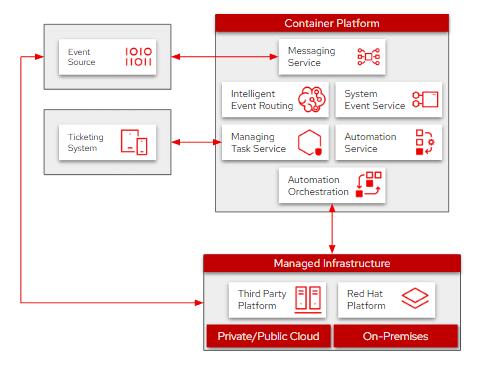In a world where the term "automation" often triggers fears of job eliminations, in the tech industry that couldn't be further from its intent. Imagine that you no longer needed to check the mail, stop for gas, recharge your cell phone, or restock groceries. Think of how much extra time you'd gain to spend with your family and friends, perhaps travel the world, invest in a hobby or even just...rest. You might already be automating some of these chores in your own life, and you're thinking "I already have my groceries delivered to my door, and my phone charges itself when I set it on my desk." That's exactly what I'm getting at. Does that make you less valuable? Or are you more productive because of it?
Though, even looking at those examples, grocery delivery still requires your manual intervention to place the order, doesn't it? Do you think we can continue to evolve your productivity even further by designing a way to get your groceries delivered without you needing to place an order? Let's say, you are making breakfast, and you're running low on coffee. Maybe you're a coffee snob like me, and you understand that for peak quality, you want to grind the beans around three days after it's roasted. Every day beyond that it loses some freshness, and after just three weeks (saying you stored it properly and only ground the beans as needed) it's considered stale. With such a short lifespan, it's crucial that not even a day is wasted.
One way you can maintain a constant supply of (relatively) fresh coffee is to set up a delivery subscription, knowing every few weeks you'll have a fresh batch delivered. But what happens if you were out of town for a few days, and you haven't finished your last batch of coffee when the new one arrives? Now you either have to manually intervene and tell it to skip or postpone an order, or you store the new batch for a few extra days, losing an average of about 5% of its freshness for every day that passes. In this concept, we've set up a sense of automation, but can we elevate that solution to make it require even less intervention, and increase your productivity even more? Let's see how event-driven automation can do this.
Let's briefly step away from this coffee example as we walk through this simple diagram below (Fig. 1), which shows the logical flow of an event through an automation architecture.

Fig. 1 - Event-driven architectural diagram
The event source starts our journey through this solution. It can be any event captured within your organization, such as a vulnerability that has been recently discovered and needs to be remediated throughout your entire enterprise estate. The event source triggers a message, which is received by a service that does a few simple things. First, it triggers the system event service that communicates with intelligent routing to make a decision based on some built-in logic to handle urgencies and priorities, should multiple requests come in at the same time.. From here, the event that's been prioritized triggers the task management service, which updates the ticketing system that will be tracking this event, as well as the automation service which will invoke the resolution available to it. The automation orchestration component will deliver this resolution across the entire managed infrastructure, regardless of platform, and whether the systems live on–premises, or in the cloud. From here, the status of this solution will be recorded and updated in the ticketing system, and any sequential events will be triggered to continue this cycle.
Now, stepping back into our coffee example: Imagine your coffee is stored in a container that has been programmed to monitor how much coffee remains. When this event source determines the supply will be consumed within a few days of running out, it triggers the event. The System Event Service communicates with some Intelligent Routing, which looks at your predefined set of preferred coffees, determines what coffees from that list are the highest priority, in stock, is able to be delivered within the required timeframe and at peak freshness and then determines which coffee will be sent out next. The Manage Task Service creates a purchase order in the ticketing system, the automation service places the order, and the coffee is then shipped out by the Automation Orchestrator.
Without ever needing to intervene, or even acknowledging that your coffee was running low, a fresh bag of coffee is delivered to your door, right on time. This is event-driven automation.
If you'd like to look deeper, head over to the next blogs in this series to review the Architectural Components of an Event Driven Architecture and Build an Example Event Driven Architecture. Or to learn more about how our customers are using event-driven in their industry, check out this architecture in full.
저자 소개
Camry Fedei joined Red Hat in 2015, starting in Red Hat's support organization as a Support Engineer before transitioning to the Customer Success team as a Technical Account Manager. He then joined the Management Business Unit in Technical Marketing to help deliver a number of direct solutions most relevant to Red Hat's customers.
채널별 검색
오토메이션
기술, 팀, 인프라를 위한 IT 자동화 최신 동향
인공지능
고객이 어디서나 AI 워크로드를 실행할 수 있도록 지원하는 플랫폼 업데이트
오픈 하이브리드 클라우드
하이브리드 클라우드로 더욱 유연한 미래를 구축하는 방법을 알아보세요
보안
환경과 기술 전반에 걸쳐 리스크를 감소하는 방법에 대한 최신 정보
엣지 컴퓨팅
엣지에서의 운영을 단순화하는 플랫폼 업데이트
인프라
세계적으로 인정받은 기업용 Linux 플랫폼에 대한 최신 정보
애플리케이션
복잡한 애플리케이션에 대한 솔루션 더 보기
오리지널 쇼
엔터프라이즈 기술 분야의 제작자와 리더가 전하는 흥미로운 스토리
제품
- Red Hat Enterprise Linux
- Red Hat OpenShift Enterprise
- Red Hat Ansible Automation Platform
- 클라우드 서비스
- 모든 제품 보기
툴
체험, 구매 & 영업
커뮤니케이션
Red Hat 소개
Red Hat은 Linux, 클라우드, 컨테이너, 쿠버네티스 등을 포함한 글로벌 엔터프라이즈 오픈소스 솔루션 공급업체입니다. Red Hat은 코어 데이터센터에서 네트워크 엣지에 이르기까지 다양한 플랫폼과 환경에서 기업의 업무 편의성을 높여 주는 강화된 기능의 솔루션을 제공합니다.

